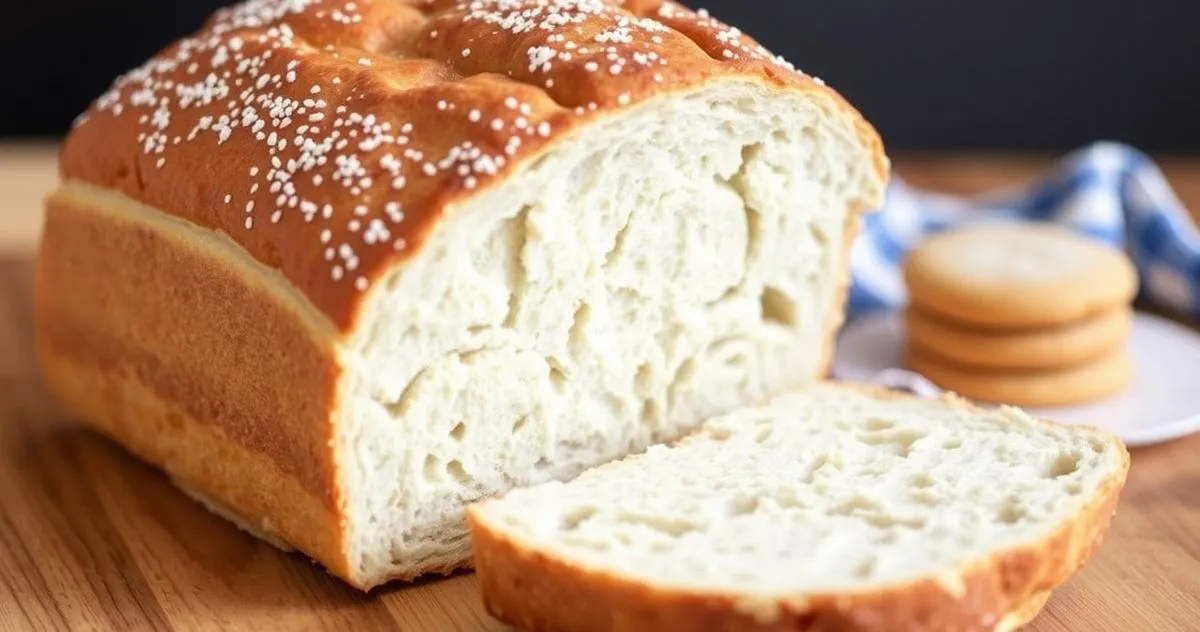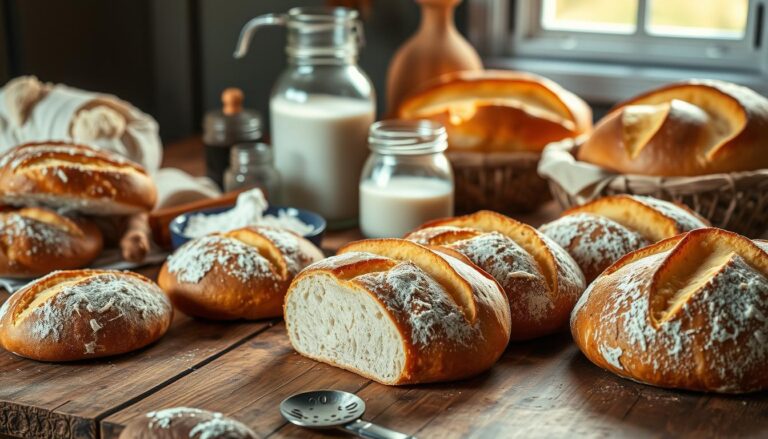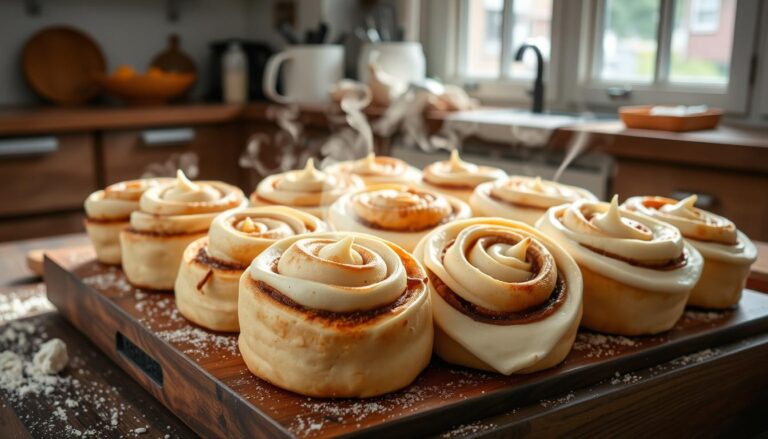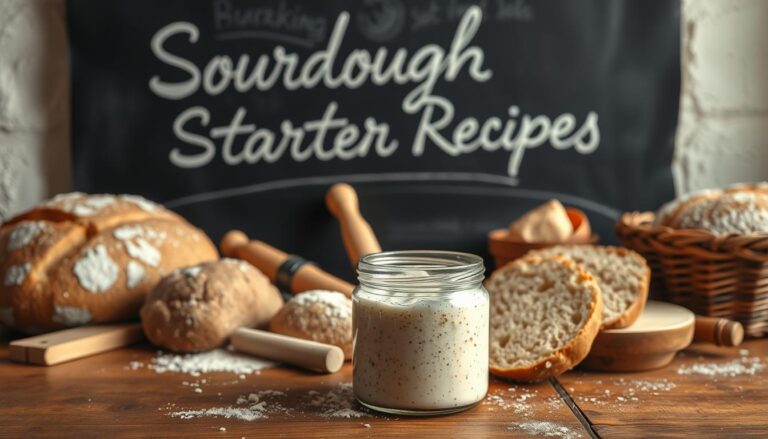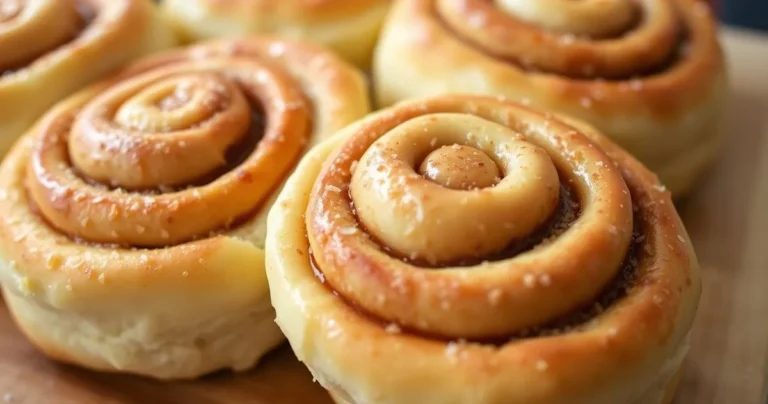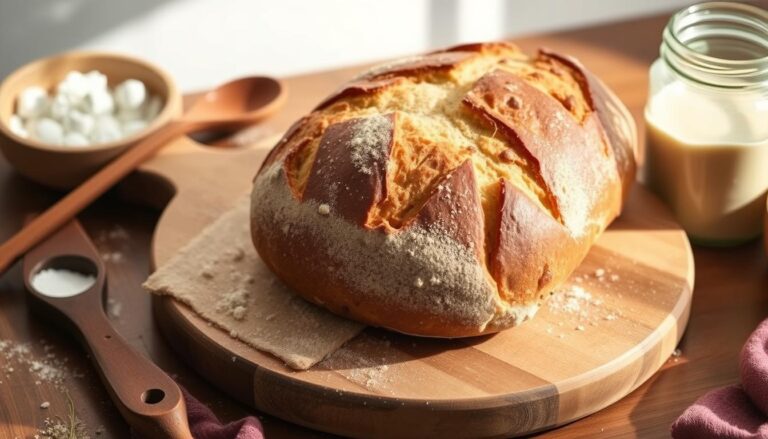Best Non-Bread Sourdough Recipes to Try Today
Table of Contents
Best Irresistible Non-Bread Sourdough Recipes to Try Today
You’ve likely heard of using sourdough starter for making bread, but its uses extend far beyond the realm of baking loaves. Exploring sourdough recipes without bread can open up a world of culinary creativity, allowing you to incorporate the unique flavor and nutritional benefits of sourdough into a variety of dishes.
With a sourdough starter, you can create a range of delicious recipes, from pancakes and waffles to pizza crusts and even desserts. The versatility of sourdough starter makes it a valuable ingredient to have in your kitchen, offering a natural way to add depth and complexity to your cooking and baking.
Key Takeaways
- Discover the versatility of sourdough starter beyond bread making.
- Explore a variety of sourdough recipes for different meals and desserts.
- Learn how to incorporate sourdough into your cooking for added flavor and nutrition.
- Find inspiration for new recipes using sourdough starter.
- Understand the benefits of using sourdough in your culinary creations.
The Versatility of Sourdough Starter Beyond Bread
Sourdough starter is more than just a bread-making ingredient; it’s a versatile component that can elevate a wide range of dishes. While traditional bread recipes are a staple for many sourdough enthusiasts, the true potential of sourdough starter lies in its ability to add depth, complexity, and nutrition to various meals and snacks.
The unique characteristics of sourdough starter make it an invaluable ingredient in many recipes. The natural fermentation process involved in maintaining a sourdough starter not only enhances flavors but also contributes to the nutritional value of the dishes it’s used in.
What Makes Sourdough Special
Sourdough starter is special due to its natural yeast and bacteria culture, which differentiates it from commercial yeast used in traditional baking. This natural fermentation process gives sourdough its distinctive tangy flavor and chewy texture, making it a favorite among bakers and chefs alike.
The benefits of sourdough starter extend beyond its flavor and texture. The lactic acid produced during fermentation acts as a natural preservative and can help in breaking down some of the gluten, making it somewhat more digestible for some individuals.
Benefits of Using Discard in Cooking
Using sourdough discard in cooking is not only a creative way to reduce food waste but also a method to infuse dishes with the unique qualities of sourdough. By incorporating discard into recipes, you can add complexity and depth to a variety of dishes, from pancakes and waffles to pizza crusts and crackers.
| Recipe Type | Benefits of Using Sourdough Discard | Example Recipes |
|---|---|---|
| Breakfast | Adds flavor and tenderness | Pancakes, Waffles, Crepes |
| Snacks and Sides | Enhances texture and flavor | Crackers, Pizza Crust, Pretzels |
| Main Dishes | Contributes to complexity and nutrition | Pasta, Dumplings, Batter for Frying |
By understanding the benefits and versatility of sourdough starter, you can explore a wide range of recipes that go beyond traditional bread making. Whether you’re looking to reduce waste, enhance flavors, or simply experiment with new recipes, sourdough starter is a valuable ingredient to have in your kitchen.
Why Try Sourdough Recipe Not Bread Options?
By venturing beyond traditional sourdough bread, you can discover a range of recipes that promote well-being and reduce waste. Sourdough starter, with its unique fermentation properties, can be a valuable ingredient in various dishes, enhancing both flavor and nutritional value.
Health Benefits of Fermented Foods
Fermented foods, such as those made with sourdough starter, offer numerous health benefits. The fermentation process increases the bioavailability of nutrients, making them easier to digest. Additionally, fermented foods contain probiotics, which support gut health and boost the immune system.
- Improved digestion due to the presence of beneficial microbes
- Enhanced nutrient absorption
- Support for the immune system
When you incorporate fermented foods into your diet, you’re not just enjoying delicious meals; you’re also taking care of your health. So, what can you do with sourdough starter beyond making bread? The possibilities are vast, and exploring them can lead to a healthier, more balanced lifestyle.
Reducing Food Waste from Discarded Starter
Using sourdough starter in various recipes helps reduce food waste by utilizing what would otherwise be discarded. This approach not only minimizes waste but also adds variety to your meals. You can incorporate discarded sourdough starter into numerous dishes, making your cooking more sustainable and reducing the environmental impact of food waste.
By adopting sourdough recipe not bread options, you’re contributing to a more sustainable kitchen. This practice encourages creativity in cooking and helps reduce the amount of waste generated from maintaining a sourdough starter.
Breakfast Delights with Sourdough Starter
Elevate your breakfast game with sourdough starter recipes that are both healthy and delicious. Incorporating sourdough starter into your morning meals not only adds a tangy flavor but also brings the benefits of fermented foods to your table. From pancakes to crepes, the versatility of sourdough starter can transform your breakfast routine.
Fluffy Sourdough Pancakes
Sourdough pancakes are a delightful breakfast treat that combines the ease of a simple pancake recipe with the complex flavors of sourdough. To make fluffy sourdough pancakes, you’ll need to balance the right amount of starter with other ingredients.
Basic Recipe:
- 1 cup sourdough starter (active or discard)
- 1 cup flour
- 2 tablespoons sugar
- 1/2 teaspoon salt
- 1 large egg
- 1 cup milk
- 2 tablespoons melted butter
Mix the ingredients and let the batter rest for a few minutes to allow the flour to absorb the liquid. Cook on a hot griddle like regular pancakes.
Tips for Perfect Texture
To achieve the fluffiest pancakes, ensure your sourdough starter is active and bubbly. Also, don’t overmix the batter, as this can lead to dense pancakes.
Crispy Sourdough Waffles
Crispy sourdough waffles are a fantastic breakfast or brunch option, offering a crunchy exterior and a tender interior. The key to crispy waffles lies in the balance of wet and dry ingredients and the right cooking temperature.
Basic Recipe:
- 1 1/2 cups sourdough starter
- 2 cups flour
- 1/2 teaspoon salt
- 1/4 cup sugar
- 2 large eggs
- 1 cup milk
- 4 tablespoons melted butter
Preheat your waffle iron and grease it lightly. Pour the batter onto the center of the iron and cook until crispy and golden.
Savory Sourdough Crepes
Savory sourdough crepes are perfect for wrapping around your favorite fillings, from spinach and feta to ham and cheese. The sourdough starter adds a depth of flavor that complements a wide range of savory ingredients.
Basic Recipe:
- 1 cup sourdough starter
- 1 1/2 cups flour
- 2 1/2 cups water
- 1/4 teaspoon salt
- 2 tablespoons butter, melted
Mix the batter until smooth and let it rest. Cook in a crepe pan or a non-stick skillet. Fill with your favorite savory ingredients and enjoy.
Savory Sourdough Snacks and Sides
Sourdough starter is not just for bread; it’s a versatile ingredient for creating delicious savory treats. You can use it to make a variety of snacks and sides that are perfect for any occasion.
Crunchy Sourdough Crackers
One of the simplest and most delicious uses for sourdough starter is making crunchy crackers. These crackers are perfect for snacking on their own or paired with your favorite dips and spreads.
To make crunchy sourdough crackers, you’ll need to mix your sourdough starter with flour, water, and salt. The dough is then rolled out thinly and cut into desired shapes before being baked until crispy.
Benefits of Sourdough Crackers:
- Easy to make
- Perfect for snacking
- Can be seasoned with various herbs and spices
Sourdough Pizza Crust
Sourdough starter can also be used to make a delicious pizza crust. There are two methods for preparing sourdough pizza crust: the overnight method and the quick same-day method.
Overnight Method
The overnight method involves mixing your sourdough starter with flour, water, salt, and yeast, then letting it ferment overnight. This slow fermentation process gives the crust a deeper flavor.
Quick Same-Day Method
If you’re short on time, you can use the quick same-day method. This involves a shorter fermentation time, allowing you to have your pizza ready in just a few hours.
| Method | Fermentation Time | Flavor Profile |
|---|---|---|
| Overnight | 8-12 hours | Deep, complex flavor |
| Same-Day | 2-4 hours | Milder, still tangy |
Sourdough Pretzels
Sourdough pretzels are another tasty snack you can make using your sourdough starter. The starter adds a unique tanginess to the pretzels, making them stand out from traditional pretzel recipes.
“The use of sourdough starter in pretzel making not only adds flavor but also provides a fun twist on a classic snack.” – Artisan Baker
To make sourdough pretzels, you’ll shape your dough into pretzels, boil them in water, and then bake until golden brown. You can also add various toppings such as salt, sesame seeds, or poppy seeds for extra flavor.
These savory sourdough snacks and sides offer a delicious way to use your sourdough starter beyond bread. Whether you’re making crackers, pizza crust, or pretzels, you’ll enjoy the unique flavors and textures that sourdough starter brings to your baking.
Main Dishes Using Sourdough Starter
You can create delicious and healthy main dishes by utilizing sourdough starter in innovative ways. Sourdough starter adds a unique flavor and can enhance the nutritional value of various dishes.
Sourdough Pasta from Scratch
Using sourdough starter in homemade pasta can add a rich, tangy flavor. To make sourdough pasta, you combine sourdough starter with flour and eggs, then knead and shape the dough into your desired pasta shape.
Sourdough Dumplings
Sourdough dumplings can be a delightful addition to soups or stews. By incorporating sourdough starter into the dumpling dough, you achieve a lighter, more tender texture.
Sourdough Batters for Frying
Sourdough starter can also be used to create a crispy batter for frying vegetables or seafood. The lactic acid in the sourdough starter helps to create a crunchy exterior while keeping the interior tender.
Vegetable Fritters
To make vegetable fritters, mix sourdough starter with flour, eggs, and your choice of vegetables. The sourdough starter enhances the flavor and texture of the fritters.
Fish and Seafood Coating
For fish and seafood, a batter made with sourdough starter can provide a crispy coating. Simply mix the starter with flour and spices, then coat your seafood before frying.
| Dish | Main Ingredients | Benefits of Sourdough Starter |
|---|---|---|
| Sourdough Pasta | Sourdough starter, flour, eggs | Rich, tangy flavor; enhanced nutrition |
| Sourdough Dumplings | Sourdough starter, flour, water, filling ingredients | Lighter, tender texture |
| Vegetable Fritters | Sourdough starter, flour, eggs, vegetables | Enhanced flavor and texture |
| Fish and Seafood Coating | Sourdough starter, flour, spices, fish/seafood | Crispy coating; tender interior |
By incorporating sourdough starter into your main dishes, you can create meals that are not only delicious but also packed with nutrients. Experiment with different recipes to find your new favorite dishes.
Sweet Treats and Desserts with Sourdough
Sourdough isn’t just for bread; it’s a game-changer for desserts too. You can leverage the unique flavor and texture it adds to create truly exceptional sweet treats. By incorporating sourdough starter into your dessert recipes, you’ll not only add depth but also enhance the nutritional value of your baked goods.
Decadent Sourdough Chocolate Cake
A sourdough chocolate cake is a moist and rich dessert that combines the tanginess of sourdough with the decadence of chocolate. To make it, you’ll need to integrate your sourdough starter into the batter, allowing the flavors to meld together during the fermentation process. As one expert notes, “The fermentation process in sourdough baking unlocks new flavors and textures, making it a perfect addition to desserts like chocolate cake.“
Cinnamon Sourdough Rolls
Cinnamon sourdough rolls are a delightful twist on traditional cinnamon rolls. The sourdough starter adds a complexity to the dough, making these rolls irresistible. To make them, you’ll mix your sourdough starter with flour, sugar, and cinnamon, then let the dough rise before baking to a golden brown perfection.
Sourdough Cookies and Brownies
Sourdough can also elevate your cookie and brownie game. Sourdough cookies have a unique texture, thanks to the fermentation process, while sourdough brownies are fudgier and more complex in flavor. For instance, chocolate chip sourdough cookies are a hit, as the sourdough starter complements the chocolate chips perfectly. Similarly, fudgy sourdough brownies are a chocolate lover’s dream, with the sourdough adding a tangy contrast to the richness of the chocolate.
Chocolate Chip Sourdough Cookies
To make chocolate chip sourdough cookies, you’ll need to incorporate your sourdough starter into the dough, along with chocolate chips and other ingredients. The result is a cookie that’s both chewy and tangy, perfect for satisfying your sweet tooth.
Fudgy Sourdough Brownies
Fudgy sourdough brownies are made by mixing sourdough starter into the batter, which adds a unique dimension to the traditional brownie recipe. The fermentation process contributes to a richer, fudgier texture, making these brownies a standout dessert.
Quick and Easy Discard Recipes
For those looking to minimize waste and maximize flavor, quick sourdough discard recipes are a must-try. Using your sourdough starter in creative ways not only reduces waste but also opens up a world of culinary possibilities. In this section, we’ll explore some of the quickest and most delicious ways to use your sourdough discard.
5-Minute Sourdough Flatbreads
One of the simplest and most versatile recipes you can make with sourdough discard is flatbread. With just a few ingredients, you can have a delicious, homemade flatbread ready in minutes. Simply mix your sourdough discard with some flour, salt, and water, and you’re ready to cook. The result is a flavorful flatbread perfect for accompanying your favorite dips or spreads.
“I’ve fallen in love with making sourdough flatbreads,” says a seasoned baker. “It’s a great way to use up discard and enjoy a fresh, homemade snack in no time.” This sentiment is echoed by many who appreciate the convenience and taste of sourdough flatbreads.
No-Wait Sourdough Muffins
Sourdough muffins are another fantastic way to use your discard, and they can be made without any waiting time. You can choose between savory and sweet options, depending on your mood. For a savory treat, consider making Savory Cheese and Herb Muffins. These are perfect for a quick breakfast or as a side to your favorite soups.
Savory Cheese and Herb Muffins
To make savory muffins, mix your sourdough discard with flour, cheese, herbs, and a pinch of salt. The result is a moist and flavorful muffin that’s sure to please. The addition of cheese and herbs gives these muffins a rich, savory taste that’s hard to resist.
Sweet Blueberry Sourdough Muffins
For those with a sweet tooth, Sweet Blueberry Sourdough Muffins are a great option. By mixing your sourdough discard with blueberries, sugar, and flour, you can create a deliciously sweet treat. The sourdough adds a depth of flavor that complements the blueberries perfectly.
These quick and easy discard recipes are just the beginning. With a little creativity, you can enjoy a wide range of delicious sourdough treats without the need for lengthy preparation times.
Tips for Successful Non-Bread Sourdough Recipes
As you explore the realm of non-bread sourdough recipes, you’ll find that a few crucial tips can make all the difference in your culinary creations. Mastering the use of sourdough starter in various dishes requires understanding its characteristics and how it interacts with other ingredients.
Understanding Starter Hydration Levels
The hydration level of your sourdough starter significantly affects its behavior in recipes. A hydration level refers to the ratio of water to flour in your starter. For instance, a starter with a 100% hydration level means it has equal parts of water and flour by weight. Understanding this ratio is crucial because it influences the starter’s activity, texture, and flavor.
To illustrate the impact of hydration levels, consider the following table:
| Hydration Level | Starter Characteristics | Suitable Recipes |
|---|---|---|
| 50% | Thick, less active | Pancakes, waffles |
| 100% | Balanced activity, creamy texture | Crackers, flatbreads |
| 150% | Very active, more liquid | Pizza dough, crepes |
Adjusting Recipes for Sourdough
When incorporating sourdough starter into non-bread recipes, it’s essential to adjust the liquid content and sometimes the leavening agents. Sourdough starter adds not only flavor but also moisture and, potentially, extra rise. As
“The key to successfully substituting sourdough starter into recipes is understanding its hydration level and adjusting accordingly.”
This might mean reducing the amount of liquid in the recipe or adjusting the ratio of flour to liquid.
- Reduce liquid in recipes if using a very wet sourdough starter.
- Adjust leavening agents if your starter is very active.
- Consider the flavor profile you want to achieve and adjust seasonings accordingly.
Storage and Shelf Life Considerations
Proper storage of your sourdough starter and baked goods is crucial for maintaining freshness and quality. For short-term storage, keep your starter at room temperature or in the refrigerator. For longer storage, consider drying or freezing your starter.
When it comes to baked goods made with sourdough, storing them in airtight containers can help maintain freshness. Some products, like crackers, can become stale quickly, while others, like cakes, may retain moisture longer.
- Store sourdough starter in an airtight container in the fridge for up to a week.
- Freeze sourdough starter for longer storage; simply thaw when needed.
- Keep baked goods in airtight containers to maintain freshness.
Conclusion
As you’ve discovered throughout this article, sourdough starter is an incredibly versatile ingredient that can be used in a wide range of dishes, from breakfast delights to sweet treats and savory snacks. With the various
sourdough recipe not bread
options available, you can experiment with new flavors and recipes, enjoying the benefits of this natural ingredient.
By incorporating sourdough starter into your cooking and baking, you can add depth and complexity to your creations. So, what can you do with sourdough? The possibilities are endless, and it’s up to you to explore and discover the many uses of this amazing ingredient.
Whether you’re making pancakes, pizza crust, or cookies, sourdough starter is sure to become a staple in your kitchen. With the tips and recipes provided, you’re ready to start your sourdough journey and enjoy the many rewards it has to offer.
FAQ
What are some creative ways to use sourdough starter beyond bread?
You can use sourdough starter in a variety of dishes, such as pancakes, waffles, crepes, crackers, pizza crust, pretzels, pasta, dumplings, and even desserts like cakes, cookies, and brownies.
How do I incorporate sourdough discard into my recipes?
Sourdough discard can be used in place of some of the flour and liquid in many recipes, adding flavor and nutrition. You can also use it to make pancakes, muffins, and other quick breads.
What are the benefits of using sourdough starter in cooking?
Sourdough starter adds a unique flavor and texture to dishes, and its natural fermentation process can enhance the nutritional value of ingredients. It can also help reduce food waste by utilizing discarded starter.
Can I use sourdough starter in sweet recipes?
Yes, sourdough starter can be used in sweet recipes like cakes, cookies, and brownies, adding a tangy flavor and tender texture.
How do I adjust recipes to accommodate sourdough starter?
When using sourdough starter, you may need to adjust the amount of liquid and flour in a recipe, as well as the rising time. Understanding the hydration level of your starter is crucial for achieving the right consistency.
What are some tips for storing and using sourdough discard?
Sourdough discard can be stored in the fridge for up to a week or frozen for later use. You can also use it immediately in recipes, or mix it with other ingredients to create a variety of dishes.
Can I make sourdough recipes without a long fermentation time?
Yes, there are many quick and easy sourdough recipes that don’t require a long fermentation time, such as 5-minute flatbreads and no-wait muffins.
What are some meal ideas that feature sourdough bread as a main ingredient?
You can use sourdough bread to make croutons, bread pudding, or as a base for appetizers and snacks. It’s also great for making sandwiches and toast.
How can I use sourdough starter to make different types of meals?
Sourdough starter can be used in a variety of meals, from breakfast dishes like pancakes and waffles, to savory snacks and sides like crackers and pretzels, and even main courses like pasta and dumplings.

